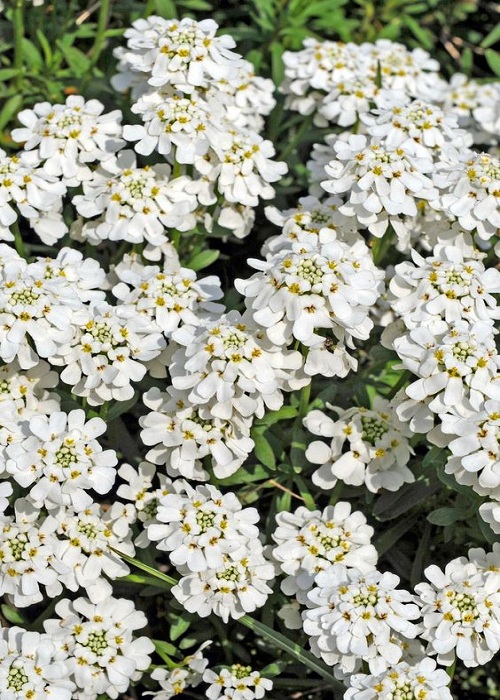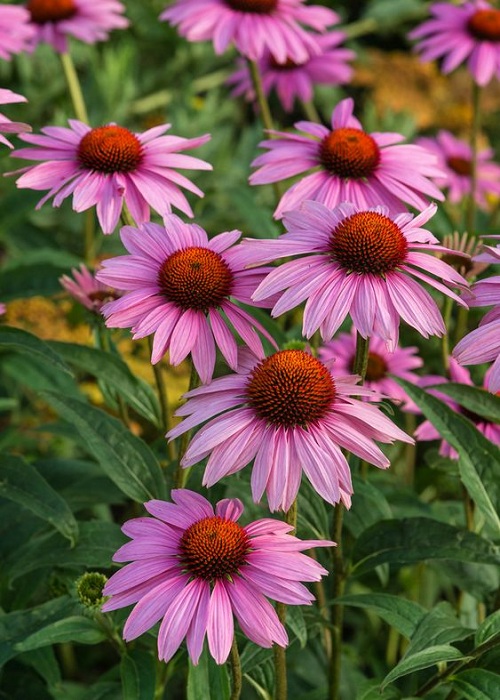It becomes increasingly difficult to maintain a garden once spring has faded and the summer heat has arrived.
So you need to seek for flowering plants—annuals and perennials alike—that bloom frequently throughout the season without requiring much attention from you.
Fortunately, there is a broad variety of summer bloomers to pick from.
Make your Garden blossom This Summer with These 15 Flowers:
PETUNIA

Annual petunias bloom from the middle of spring through the end of the fall, making them one of the longest-blooming plants.
‘Purple Wave’ hybrid petunias, often known as ‘Hybrid Petunias with the Trailing Habit’, are incredibly floriferous and versatile. They were first available in purple, but are now available in numerous colours of pink, purple, blue, and red, as well as creamy white.
Petunia seeds are difficult to grow indoors, so it’s preferable to buy young plants from a nursery.
Once the threat of frost has passed, either plant them in well-draining beds in a sunny position, or grow them in containers. Hanging pots are a great use for them. Water and feed them on a regular basis to keep them healthy.
ZINNIAS

Zinnias thrive in warm weather, so they are consistent summer bloomers, filling the garden with long-lasting flowers in jewel tones.
Small daisy-type zinnias and huge pom-pom varieties are available, as well as everything in between.
The crossbreeding variety A excellent option for fall is the Profusion Zinnia, which continues to bloom until the end of the year Dwarf varieties are ideal for use as bedding plants and for edging.
Sunlight is essential for these annuals. It’s a good idea to water and feed them on a regular basis in hot weather.
GAILLARDIA

Similarly, the gaillardia is a perennial summer bloomer that never seems to tire of putting on a show all season long. These North American indigenous are bright yellow in color, with rich maroon and scarlet centers.
Poor soil and neglect seem to encourage their growth, making them an excellent choice for filling in bare spots in the landscape. Even if you don’t remove the spent flowers, the plants will continue to bloom.
If divided every 2-3 years, these short-lived perennials will live longer. Annual gaillardias, which may be grown from seed, are also available.
GLOBE AMARANTH

When globe amaranth blooms, the compact mounds are frequently covered with globular flowerheads all summer and fall.
They can be used in vases and bouquets because they don’t fade. Bunches are commonly dried in the shade for dried flower bouquets and potpourri since they keep much of their color when dried.
The brightly colored pom-poms of these deer resistant, drought tolerant annuals can be grown in beds or borders for a long display.
The most prevalent hue is purple, but they can also be seen in light pink, lilac, white, and red.
HYDRANGEAS

When it comes to showering your yard with a profusion of long-lasting blossoms beginning in spring, nothing beats these perennials. All summer long, the plants are covered in huge flower heads that last long after the blooming season has ended.
Choose from the several varieties—Bigleaf, Oakleaf, Panicle, or Smooth—or have them all in different places.
Hydrangeas are grown through cuttings and should be sited with care, taking into account the quantity of sun and water they will receive.
In hotter climates, they prefer early sun and afternoon shade, but in cooler climates, they may tolerate full sun for the whole of the day.
ROSE OF SHARON/HARDY HIBISCUS

Rose of Sharon is a hardy perennial hibiscus that grows well in zones 5-8 on the United States climate zone map. It comes in a variety of hues of pink, peach, and red when it’s in full bloom.
This resistant relative of the tropical hibiscus, despite its smaller individual blossoms, makes up for it with the sheer number of flowers it produces. They’ll keep arriving until the ground freezes over and destroys everything but the underground bits in the late spring.
Plant hardy hibiscus in a sunny spot with rich, well-draining soil. If you live in a hot climate, they’ll appreciate some midday shade. Water and mulch the soil often to keep it moist. In order to assist the plant continue to produce flowers, give it an occasional feeding.
COREOPSIS

When it comes to low-growing plants that are known as tickseeds, coreopsis is an old-time favorite. In warmer regions, it is a perennial, but it is more commonly grown as an annual elsewhere.
For maximum impact, the yellow and gold flowers are held high above the foliage by slender, long stalks. It’s nonstop until the end of summer and the beginning of October once they appear, which is usually near the end of spring. Deadheading encourages additional blooms.
The best place to grow coreopsis is in full sunlight. They make excellent ground coverings and flowerbeds.
MARIGOLD (TAGETES)

French Marigolds are well-known among gardeners for their use as a pest deterrent. They have a bushy, slightly spreading habit, and are small in stature and shape.
The petals of its yellow-orange flowers, which are typically tinged with red-maroon, are usually solitary or double. Their African counterparts, on the other hand, are taller and more upright, with big yellow, orange, and cream pom-poms as a result.
Marigolds of many shapes and sizes, including the miniature “Signet” marigolds, thrive in warm climates and bloom throughout the spring and fall.
It is possible to cultivate marigolds from seeds, although hybrid seeds may not yield the desired results. In bright spots, they make excellent bedding plants. You must water your plants regularly.
YARROW

Common yarrows, which have off-white or yellow blossoms and are considered weeds, have undergone a change with various new color options in pink, cream, peach, and red.
Because of their long blooming period, they’re a great addition to a summer garden. The fern-like leaves, as well as the herb’s medicinal properties, are also a plus.
Plant yarrow in full sun, but monitor its growth to prevent it from getting out of hand. Cut off the flat-topped flower heads to limit self-seeding because they look nice in bouquets.
CANDYTUFT

Clusters of tiny blooms appear in the spring on these hardy, ground-hugging evergreen plants, which can beautify any corner of the garden.
The green mounds spread as they become covered in white, purple, or pink blooms, making them ideal as fillers in the garden or in containers. Another advantage is that they keep their leaves throughout the winter in USDA zones 5-9.
It is possible to grow candytuft in both full sun and moderate shade. Just make sure to water the soil on a regular basis.
PURPLE CONEFLOWER / ECHINACEA

This native flowering plant, with its huge, purplish-pink flowers, should be in every garden.
The large cones in the middle of a single layer of somewhat reflexed petals are clearly the source of the common name. Hybrids now come in a wider range of colors and shapes.
Propagation is done through root or clump divisions of the purple coneflowers. Ensure that this perennial doesn’t get disturbed once you plant it.
Flowers can be collected throughout the summer and fall to make herbal tea. All components of the plant, in fact, are therapeutic.
ERYNGIUM (SEA HOLLY)

Sea holly’s silvery blue and spiky flowers and foliage are a stark contrast to the regular garden plants’ foliage and blossoms. It would look great in a summer garden.
It is an excellent choice for xeriscapes because it is tolerant of dryness and poor soil and may be sprayed with salt spray if necessary. Flower spikes can be used in both fresh and dried flower arrangements, and they last a long time. The plants can be grown as specimens or as bedding plants in full light.
ASTER

Summer and fall can be cheered up by the daisy-like flowers that are asters, which come in a wide range of colors. Cut-and-come-back nature keeps your vases full and your flower gardens beautiful.
It’s possible to grow asters from seed, but it’s much easier to buy young plants. Planting them in the spring will give you blooms all the way through the summer and into the fall.
In both full and partial sun, asters perform well. However, asters can’t withstand temperatures above 90 degrees Fahrenheit. These beauties thrive in soil that is rich and moist, with good drainage.
DAYLILIES

Spring through autumn is prime time for daylilies to bloom. Even if each flower only blooms for a single day, the constant stream of blooms in your garden ensures that it always appears bright.
Daylilies grab attention because their blossoms are borne on long stalks that rise above the mound of leaves. To brighten up any secluded area of the yard, these plants are a perfect choice.
Divide daylilies and grow new plants. Smaller gardens will benefit from the shorter hybrid Stella de Oro, which is an excellent option. During this time, it has the longest flowering period of any plant.
RUDBECKIA

Wildflowers like this one deserve a home in our gardens because of their huge and prolific blooms. The contrast between yellow petals and black center disc is what makes these huge, brightly colored blooms so appealing to the eye. It’s possible to grow Rudbeckia as an annual if you start it early enough, but it’s a perennial.
They begin blooming in the early summer in most regions and continue until the fall. However, in locations with warmer summers, blossoming begins in the fall and lasts into the winter months.

